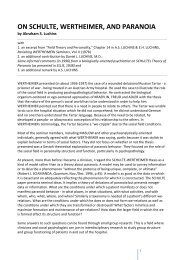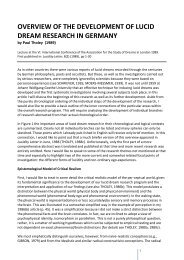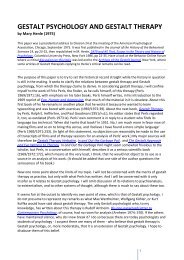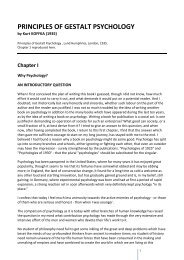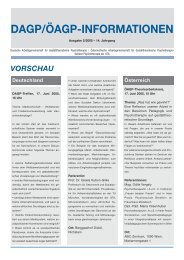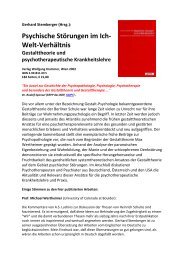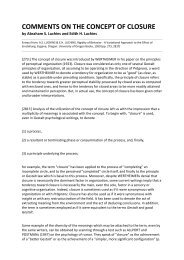Gestalt Factors in Human Movement Coordination - Society for ...
Gestalt Factors in Human Movement Coordination - Society for ...
Gestalt Factors in Human Movement Coordination - Society for ...
You also want an ePaper? Increase the reach of your titles
YUMPU automatically turns print PDFs into web optimized ePapers that Google loves.
Mechsner, <strong>Gestalt</strong> <strong>Factors</strong> <strong>in</strong> <strong>Human</strong> <strong>Movement</strong> Coord<strong>in</strong>ation 239which are used <strong>in</strong> order to better control the movement. In fact, the reported strategyof symmetry control often leads to a distortion of the exact mirror-symmetrical pattern:observers ma<strong>in</strong>ta<strong>in</strong> the correct spatial relationship of the flags at the meet<strong>in</strong>gpo<strong>in</strong>t, whereas the rest of the trajectories are more variable.It must be noted, however, that the “central po<strong>in</strong>t strategy”, <strong>in</strong>clud<strong>in</strong>g the accompany<strong>in</strong>gtrajectory distortions, seems much more pronounced <strong>in</strong> the flag-circl<strong>in</strong>g taskthan <strong>in</strong> the hand-circl<strong>in</strong>g task. This may be so because the flags can only be controlledvisually, which means that their spatial relationship is especially well perceivedwhen the flags meet <strong>in</strong> the middle. In comparison, k<strong>in</strong>esthetic perception ofthe hands may still be rather good if the hands are somewhat apart from each otherthough they can not so well be seen any more.It still has to be <strong>in</strong>vestigated whether participants actually behave <strong>in</strong> the way theyreport. However, it seems plausible, so far, that the perceived difficulty of a movementpattern is reveal<strong>in</strong>g the difficulty of the particular perceptual strategy used, andnot a difficulty caused by whether one has to con<strong>for</strong>m or to oppose dist<strong>in</strong>ct tendenciesof a motoric orig<strong>in</strong>. It may well be that it is not so much the symmetry as suchbut rather the specific control strategies used which makes per<strong>for</strong>mance of symmetryso easy.Intention as an organiz<strong>in</strong>g pr<strong>in</strong>ciple <strong>in</strong> human movementsLet us consider the factor of “sw<strong>in</strong>g” a little more <strong>in</strong> depth. To this po<strong>in</strong>t, we considereda skillful sw<strong>in</strong>g, loosely speak<strong>in</strong>g, as an aptly timed impulse allow<strong>in</strong>g the optimaluse of <strong>in</strong>duced k<strong>in</strong>etic energy. Taken as such, a skillful sw<strong>in</strong>g seems to fulfill anoptimality criterion <strong>for</strong> mov<strong>in</strong>g <strong>in</strong> the most economical way with m<strong>in</strong>imum energyexpenditure. The degree of atta<strong>in</strong>ed optimality <strong>in</strong> this regard has a clear counterpart<strong>in</strong> the experienced movement quality. Thus one may plausibly suggest that sw<strong>in</strong>g isa <strong>Gestalt</strong> criterion especially tailored <strong>for</strong> movement control. However, a most importantdimension of sw<strong>in</strong>g is still lack<strong>in</strong>g <strong>in</strong> our considerations: sw<strong>in</strong>g is only optimalwhen the movement goal is actually achieved. We have been consider<strong>in</strong>g sw<strong>in</strong>g asa causal structure, but we must also consider its f<strong>in</strong>al, or teleonomic, structure. Thebasic characteristic of our body movements is <strong>in</strong>tentionality, i.e., loosely speak<strong>in</strong>g,goal-orientedness. It is the always present <strong>in</strong>tentionality of our body movements,which makes them “<strong>Gestalt</strong>en” much different from object movements.Accord<strong>in</strong>g to MERLEAU-PONTY (1945), bodily movements reveal the <strong>in</strong>tentionalstructure of phenomenological space. Voluntary movements are “wholes” as, fromthe beg<strong>in</strong>n<strong>in</strong>g, they pursue and reveal an <strong>in</strong>tention. For <strong>in</strong>stance, <strong>in</strong> a grasp<strong>in</strong>g movementthe start<strong>in</strong>g hand is already unified with the <strong>in</strong>tended object to-be-grasped. Thedifference between the actual hand position and the <strong>in</strong>tended hand position is experiencedas a “tension” or “polarity” between hand and object. Intentional phenomenalspace, and thus movement space, is structured by polarities of this k<strong>in</strong>d. In analogyto potential fields <strong>in</strong> physics, one may rightly speak of phenomenal fields. Much likephysical fields, phenomenal fields are structured by attraction and repulsion centers(LEWIN 1936; METZGER 1969).



